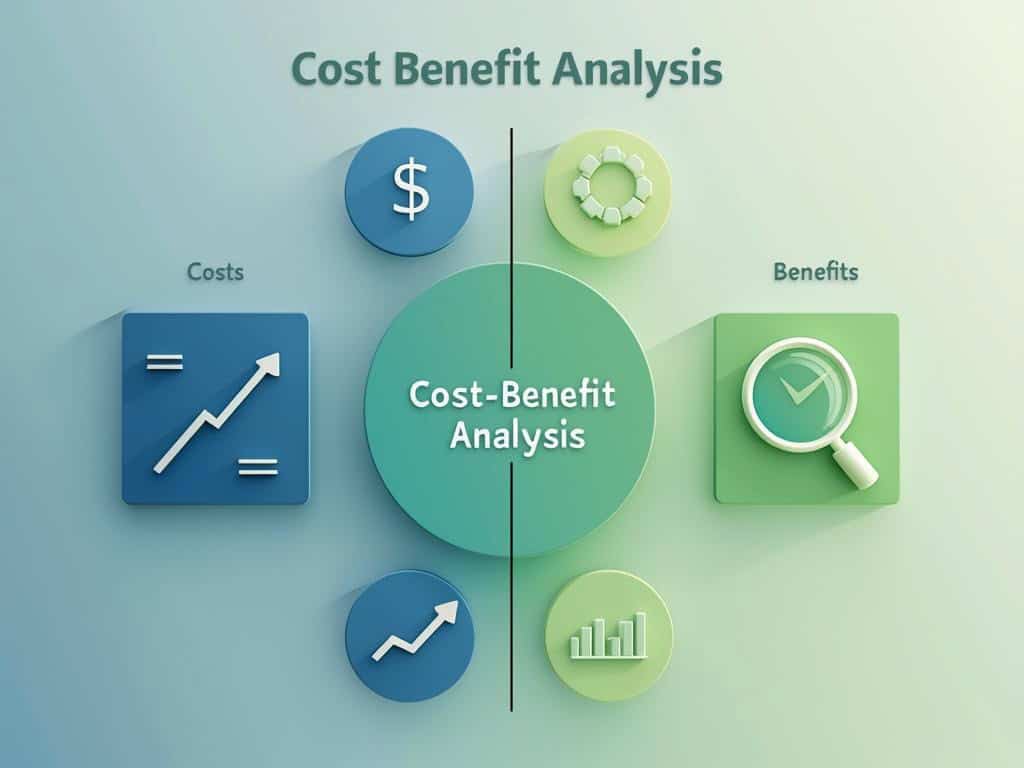
Understanding Commercial Cost-Benefit Analysis
Commercial cost-benefit analysis serves as a crucial strategic decision-making tool for organizations. It allows you to systematically evaluate potential investments by quantifying and comparing anticipated costs against expected benefits. Through financial metrics, sensitivity analysis, and comprehensive assessment techniques, you can transform complex financial data into actionable insights that guide your resource allocation and strategic planning.
Key Takeaways:
- Commercial cost-benefit analysis requires thorough examination of direct, indirect, intangible, and opportunity costs to ensure comprehensive financial evaluation.
- Multiple financial metrics like Net Present Value (NPV), Cost-Benefit Ratio, and Internal Rate of Return (IRR) provide nuanced perspectives on project viability.
- Sensitivity analysis helps identify critical variables and potential risks that could impact project outcomes.
- Effective cost-benefit analysis integrates quantitative data with qualitative insights to support more robust decision-making.
- Implementing systematic cost-benefit analysis techniques can significantly improve organizational investment strategies and resource optimization.
Making smart investment decisions relies on proper cost-benefit analysis to evaluate options thoroughly. The process helps you identify which projects deserve funding and which don’t meet financial thresholds. Each analysis should consider both immediate expenses and long-term financial implications.
Financial Metrics
Financial metrics provide essential benchmarks for evaluating investment opportunities. NPV calculations account for the time value of money, giving you a clear picture of future cash flows in today’s terms. IRR determines the percentage return a project generates, allowing for direct comparison with your required rate of return. The cost-benefit ratio offers a straightforward metric that shows benefits per dollar spent.
Sensitivity Analysis
Sensitivity analysis plays a key role in risk assessment. By testing how changes in key variables affect outcomes, you can identify which factors most impact project success. This helps prepare contingency plans for various scenarios.
Integrating Qualitative Factors
Modern cost-benefit analysis extends beyond pure numbers. Integrating qualitative factors like strategic alignment, market positioning, and employee satisfaction creates a more complete evaluation framework. This balanced approach leads to better decisions that support both financial goals and organizational objectives.
“Commercial cost-benefit analysis empowers organizations to transform complex financial data into actionable insights, ensuring strategic decisions are grounded in rigorous evaluation of anticipated costs versus benefits. By integrating quantitative metrics with qualitative evaluations, businesses can enhance their investment strategies and optimize resource allocation for sustainable growth.”
Understanding Cost Components
Every commercial cost-benefit analysis hinges on accurate cost identification. Your ability to recognize and quantify all expenses will directly impact the reliability of your decision-making process. A comprehensive commercial cost-benefit analysis requires thorough examination of several cost categories.
Direct costs form the foundation of your commercial cost-benefit analysis. These include tangible expenses like labor wages, raw materials, equipment purchases, and specific implementation costs that can be directly attributed to a project. When conducting a commercial cost-benefit analysis, you’ll need to gather precise figures for these items to establish your baseline investment.
Indirect costs often get overlooked in a commercial cost-benefit analysis but are equally important. These include overhead expenses, utility costs, and administrative expenditures that support your project but aren’t directly traceable to specific deliverables. Project acceleration efforts often increase these indirect costs significantly.
Don’t forget intangible costs when performing your commercial cost-benefit analysis. While harder to quantify, factors like potential impacts on employee morale, customer satisfaction, and organizational culture carry real financial implications. Converting these elements into monetary terms requires careful estimation and sometimes specialized valuation techniques.
Opportunity costs represent a critical dimension of commercial cost-benefit analysis that many decision-makers underestimate. These reflect the potential benefits you’ll forgo by committing resources to one project instead of alternatives. Make-or-buy decisions highlight these opportunity costs particularly well.
Here’s a breakdown of the key cost categories to include in your commercial cost-benefit analysis:
| Cost Type | Description | Examples |
|---|---|---|
| Direct | Expenses directly attributable to the project | Materials, dedicated labor, equipment |
| Indirect | Supporting expenses not directly traceable | Overhead, utilities, administration |
| Intangible | Non-physical costs with real impact | Morale effects, reputation changes |
| Opportunity | Value of foregone alternatives | Profits from rejected projects |
Advanced Cost Categorization Techniques
Your commercial cost-benefit analysis gains precision through further categorization. Fixed versus variable costs help you understand how expenses will change with project scale. One-time versus recurring costs impact your long-term financial planning. Understanding risk tolerance helps determine appropriate contingency reserves in your commercial cost-benefit analysis.
Commercial cost-benefit analysis requires you to look beyond obvious expenses. Hidden costs like maintenance requirements, training needs, and compliance expenses can significantly impact your bottom line. By identifying and quantifying these costs early, you’ll avoid unpleasant surprises that derail project success and compromise your strategic objectives.
Expert Insight: When performing a commercial cost-benefit analysis, ensure you meticulously account for all types of costs, including direct, indirect, intangible, and opportunity costs. Direct costs, such as materials and labor, form your investment foundation, while indirect expenses, though less visible, are crucial for a complete financial picture. Don’t overlook the importance of advanced categorization techniques to uncover hidden costs and understand how fixed and variable expenses will impact your long-term financial planning.
Identifying and Valuing Project Benefits
Identifying and quantifying benefits is a crucial component of any commercial cost-benefit analysis. You’ll need to systematically evaluate both direct and indirect advantages to make informed decisions about project viability. When conducting a thorough commercial cost-benefit analysis, categorizing benefits helps you build a comprehensive picture of potential returns.
Direct benefits are the most straightforward to identify and quantify. These include increased revenue streams, sales growth, cost reductions, and improved operational efficiencies. For example, implementing a new inventory management system might directly reduce stockout situations by 15%, resulting in quantifiable revenue gains.
Indirect benefits contribute significant value but may be harder to measure precisely. These include enhanced brand reputation, improved market positioning, and stronger competitive standing. While challenging to quantify, strategic planning experts recommend assigning monetary values to these benefits through market research and competitive analysis.
Intangible benefits often represent the hidden value in commercial cost-benefit analysis. Consider these key intangibles:
- Increased employee productivity and satisfaction
- Enhanced customer loyalty and lifetime value
- Improved organizational knowledge and capabilities
- Better decision-making capabilities
- Reduced operational risks
The competitive advantages gained through strategic initiatives should be central to your commercial cost-benefit analysis. First-mover advantages, market differentiation, and intellectual property protection all create sustainable value. When evaluating these benefits, you must consider both immediate and long-term impacts on your competitive position.
Benefit Quantification Methods
Converting benefits into monetary terms requires systematic approaches. The following table outlines effective quantification methods for different benefit types:
| Benefit Type | Quantification Method | Example |
|---|---|---|
| Revenue Increase | Market research and sales forecasting | $250,000 annual increase |
| Cost Reduction | Process analysis and efficiency modeling | 15% reduction in operational costs |
| Customer Retention | Customer lifetime value calculations | $120 average increase per customer |
| Risk Reduction | Probability-weighted risk scenarios | $80,000 in avoided expenses |
| Brand Value | Market share analysis and valuation techniques | 8% increase in brand equity |
Effective benefit identification requires input from multiple stakeholders. Stakeholder satisfaction drives comprehensive commercial cost-benefit analysis by ensuring all perspectives are considered. You should engage finance, operations, marketing, and customer-facing teams to identify benefits across organizational functions.
When documenting benefits for your commercial cost-benefit analysis, clearly distinguish between one-time and recurring benefits. A recurring benefit of $50,000 annually has significantly different implications than a one-time gain of the same amount. This distinction impacts discounting calculations and long-term value assessments.
The time horizon for realizing benefits varies considerably across projects and should be explicitly factored into your commercial cost-benefit analysis. Some initiatives deliver immediate returns while others require sustained investment before generating significant benefits. Map benefits against a realistic timeline to avoid overestimating short-term returns.
Companies that focus on identifying and quantifying project benefits are twice as likely to complete initiatives on time and budget, leading to more successful outcomes.
hbr.org
Calculation Methods and Financial Metrics
A thorough commercial cost benefit analysis relies on robust financial metrics to transform raw data into actionable insights. Your ability to select and apply the right calculation methods directly impacts decision quality and project outcomes.
The Net Present Value (NPV) formula serves as a cornerstone metric in commercial cost benefit analysis. Calculate it using: NPV = PV(Benefits) – PV(Costs). This calculation discounts future cash flows to present value, accounting for the time value of money. A positive NPV indicates a potentially profitable venture, while a negative result suggests reconsideration of the project.
Cost-Benefit Ratio offers another critical measurement, calculated as: PV(Benefits) ÷ PV(Costs). When this ratio exceeds 1.0, benefits outweigh costs, suggesting a favorable investment. This metric helps you simplify complex project decisions by reducing multiple factors to a single comparative value.
Present Value calculations form the foundation of these metrics: PV = FV ÷ (1+r)^n, where:
- FV represents future value
- r equals the discount rate
- n is the number of time periods
Key Financial Metrics for Comprehensive Analysis
Beyond these basic calculations, a complete commercial cost benefit analysis incorporates additional metrics that provide deeper insights:
- Internal Rate of Return (IRR) – The discount rate at which NPV equals zero
- Payback Period – Time required to recover initial investment
- Return on Investment (ROI) – Percentage gain relative to cost
- Profitability Index – Ratio of investment benefits to costs
- Discounted Cash Flow (DCF) – Sum of all discounted future cash flows
The selection of appropriate metrics depends on your specific analysis needs. Different commercial cost benefit analysis scenarios require different evaluation approaches. For instance, go/no-go decisions may emphasize payback period, while long-term strategic investments might prioritize NPV and IRR.
Successful implementation requires accurate data collection and consistent methodology. You’ll need to establish clear parameters for discount rates, time horizons, and cash flow projections. This systematic approach helps minimize bias and provides a foundation for objective decision-making in your commercial cost benefit analysis process.
Organizations that adopt formal cost-benefit analysis techniques are 30% more likely to make effective investment decisions.
forbes.com
Sensitivity Analysis and Risk Management
A thorough commercial cost-benefit analysis isn’t complete without testing how potential changes might affect your bottom line. Sensitivity analysis lets you examine how variations in key variables impact your overall outcomes and ROI. You’ll need this critical step to identify which factors pose the greatest risk to your project’s financial success.
When conducting a commercial cost-benefit analysis, you should test different scenarios by adjusting variables like:
- Revenue projections (±10-20%)
- Implementation timeframes (delays of 3-6 months)
- Market adoption rates (slower/faster uptake)
- Resource costs (labor, materials, technology)
- Discount rates (testing different values)
By modeling these variables, you can determine which ones most dramatically impact your project’s viability. This helps you develop targeted risk response strategies before issues arise.
Scenario Planning for Risk Mitigation
Creating multiple scenarios is essential for comprehensive commercial cost-benefit analysis. You should develop at least three scenario models:
- Best-case scenario – All variables perform at optimal levels
- Expected-case scenario – Most likely outcome based on reasonable assumptions
- Worst-case scenario – Conservative estimates with potential challenges
These scenarios provide a range of potential outcomes rather than a single static prediction. When presenting your commercial cost-benefit analysis to stakeholders, this approach demonstrates your thorough risk assessment and builds confidence in your strategic decision-making process.
Effective risk management also requires identifying critical thresholds where the commercial cost-benefit analysis turns negative. This establishes clear “trigger points” for when to reconsider or modify your approach. You’ll need to develop contingency plans for these scenarios to ensure project viability even when facing unexpected challenges.
By incorporating sensitivity analysis into your commercial cost-benefit analysis, you’ll gain a deeper understanding of project vulnerabilities and opportunities. This approach transforms your analysis from a static estimate into a dynamic tool for ongoing project evaluation and risk management.

Practical Applications and Strategic Implementation
Commercial cost benefit analysis serves as a cornerstone for effective business decision-making across various scenarios. You’ll find this analytical approach invaluable when evaluating potential projects and strategic initiatives. A thorough commercial cost benefit analysis helps you identify which investments will deliver the greatest returns and align with your organizational objectives.
When initiating new projects, commercial cost benefit analysis provides the foundation for determining feasibility. Before committing resources, you can evaluate all investment options systematically, comparing their potential value against implementation costs. This prevents wasting resources on initiatives that won’t deliver adequate returns.
Resource allocation becomes significantly more strategic when guided by commercial cost benefit analysis. By quantifying expected returns, you can prioritize projects that offer the highest value per dollar invested. This optimization ensures your limited resources generate maximum impact across the organization.
Technology investments particularly benefit from rigorous commercial cost benefit analysis. When evaluating new systems or software, you must consider:
- Initial purchase and implementation costs
- Ongoing maintenance and upgrade expenses
- Training requirements and potential productivity losses during transition
- Expected efficiency gains and revenue improvements
- Competitive advantages from technological advancement
Your strategic planning across all organizational levels should incorporate commercial cost benefit analysis as a standard practice. By implementing this methodology consistently, you create a data-driven decision culture that improves organizational performance. This approach helps strengthen strategic planning by removing guesswork from major decisions.
Industry-Specific Applications
Different sectors leverage commercial cost benefit analysis in specialized ways to optimize their operations. The following table highlights key industry applications:
| Industry | Commercial Cost Benefit Analysis Applications |
|---|---|
| Manufacturing | Equipment upgrades, automation initiatives, facility expansions |
| Healthcare | New treatment protocols, facility improvements, technology adoption |
| Financial Services | Digital transformation projects, customer service enhancements, security upgrades |
| Retail | Store renovations, e-commerce platform development, supply chain optimization |
| Information Technology | Infrastructure updates, software development, cybersecurity enhancements |
The commercial cost benefit analysis process becomes even more valuable when implemented with project management best practices. You should conduct regular strategic reviews of ongoing initiatives against their original cost-benefit projections to ensure they remain viable and adjust course when necessary.
Maximizing CBA Effectiveness
You’ll achieve optimal results from your commercial cost benefit analysis by blending rigorous quantitative methods with insightful qualitative perspectives. A commercial cost benefit analysis shouldn’t rely solely on numbers—incorporating stakeholder feedback and expert judgment enhances your decision-making process.
When conducting a commercial cost benefit analysis, comprehensive data collection forms the foundation of your assessment. Don’t cut corners during this phase—ensure you’ve gathered information on all relevant costs and benefits, both tangible and intangible. This includes tracking direct expenses like labor and materials while also accounting for harder-to-quantify factors such as brand reputation impacts and employee satisfaction.
Common biases can undermine your commercial cost benefit analysis if left unchecked. These include:
- Optimism bias: Overestimating benefits and underestimating costs
- Anchoring bias: Placing too much weight on initial estimates
- Confirmation bias: Focusing on information that supports preferred outcomes
- Status quo bias: Undervaluing change compared to current conditions
To counter these biases, implement robust project assurance processes that challenge assumptions and validate inputs. Create diverse analysis teams to bring multiple perspectives to your commercial cost benefit analysis.
Enhancing Decision Quality Through CBA Integration
Your commercial cost benefit analysis should integrate with broader strategic planning processes rather than functioning as a standalone exercise. This integration ensures your analysis addresses key organizational priorities and accounts for long-term strategic impacts beyond immediate financial returns.
Regular review cycles strengthen your commercial cost benefit analysis by incorporating new information as it becomes available. Establish formal checkpoints to reassess assumptions and adjust projections based on emerging data. This dynamic approach to commercial cost benefit analysis allows for course correction and helps maintain alignment with changing business conditions.
Digital tools can significantly enhance your commercial cost benefit analysis capabilities through improved data visualization, automated sensitivity testing, and more sophisticated modeling. These technologies enable you to conduct root cause analysis when examining cost drivers and benefit factors, leading to more nuanced insights.
The most effective commercial cost benefit analysis processes involve key stakeholders throughout the assessment. This collaborative approach not only improves the quality of inputs but also builds buy-in for eventual decisions. When stakeholders participate in your commercial cost benefit analysis, implementation barriers often diminish as participants develop shared understanding of the rationale behind choices.






